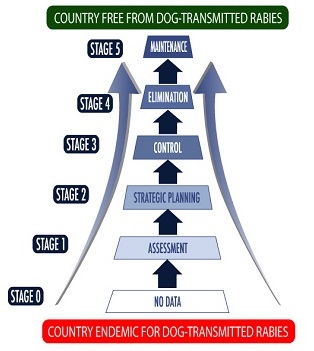Helping countries to help themselves: the updated SARE tool
As the fight against rabies continues to evolve and adapt, so must the tools that are used to win that fight.
With the global drive towards canine-mediated human rabies elimination by 2030 on the tongues of everybody in the rabies field these days, there is a lot of attention focused on this achievable goal. Yet, many countries face a challenging task ahead of them because most rabies-endemic countries in Africa and Asia are still in the early stages of this fight. As many publications, presentations and speeches before this have highlighted, the global community is making every effort to help these countries to initiate effective and sustainable control programmes, whilst also encouraging more advanced countries to showcase their efforts and share their experiences as they reach their elimination targets.
The ever-present dilemma of the cycle of neglect has hindered any substantial progress historically; however, with the support from the global community and the tools that have been developed in more recent years, it is now possible to break this cycle. One such tool in identifying the means to break the cycle of neglect is the Stepwise Approach towards Rabies Elimination (SARE) tool that has been incorporated into the Blueprint for Rabies Control (http://rabiesblueprint.org). The SARE tool enables countries to perform self-assessments of their own unique rabies situation and creates a score based on specific achievements that each country has completed. Thus, a score from stage 0–5 is provided at a glance, giving an immediate overview of the progress the country has made towards being free from canine rabies. With a more in-depth analysis of the outputs, the tool highlights the exact activities that have been completed as well as those that are pending. By using these pending activities as guidelines for the next steps needed to achieve elimination, countries are able to easily and effectively identify areas of concern or target areas for further attention.
The SARE tool is now more than 2-years old, and although some minor revisions have been made, some of the questions were either unclear or vague, expecting users to have an in-depth knowledge of the SARE concept and an understanding of the processes that have been developed. In light of this, GARC in collaboration with the FAO and other partners has worked tirelessly over the past months to revise and improve upon the SARE tool.
Revisions and updates to the tool:
- Clarified instructions to users
- Locked access until instructions are read
- Revision of activities in each stage
- Improved and revised SARE diagram
- Automatic scoring of stage
- Direct links to Blueprint for Rabies Control
- Addition of activities to clarify progression
- Progression on activities revised
- Improved Dog-population management (DPM) criteria
- Improved Information, Education and Communication (IEC) criteria
- Improved language and clarity on questions
The newest version of the SARE tool has already been pre-tested in the Philippines and subsequently beta-tested at a Philippines sub-national meeting. Furthermore, the revised tool was launched at the GARC-WAP joint rabies elimination planning workshop that was held in South Africa from 25-26 October 2016. Delegates found that using and interpreting the tool was far easier than before, with the majority of delegates being able to complete the assessment with little help or clarification from the facilitators.
Although the tool has been substantially improved, there will always be ways to better the tool for use in various situations. Because of this, a dedicated team of experts from around the world continue to work on the SARE tool to ensure that it provides easy-to-use, accurate and much needed guidance to rabies-endemic countries to help them reach their globally accepted goal of canine-mediated human rabies elimination by the year 2030.
More information about the SARE can be found here, and the updated SARE tool will be incorporated into the blueprint shortly.
Submitted by Terence Scott and Andre Coetzer, GARC and members of the Pan-African Rabies Control Network (PARACON) Steering Committee
